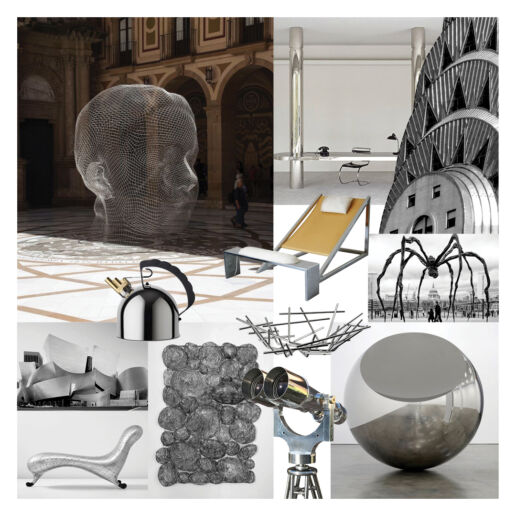Stainless Steel
From the smallest of zippers to gargantuan skyscrapers, stainless steel has long been an indispensable material in our lives. Its strength and resistance to corrosion make it the ideal material for numerous everyday applications. Besides a long lifespan, stainless steel can be recycled. Recycled material accounts for about 90% of the stainless steel we use, increasing its appeal for promoting sustainable practices.
The recipe for steel
Stainless steel is an alloy composed mostly of iron and some 10.5% of chromium. The amount of chromium determines resistance to corrosion and rust. The alloy stainless steel also contains elements such as nickel, iron and carbon. The quality of the material is affected severely should an error occur with the amounts of either one. Stainless steel is expensive yet its properties and extended service life compensate for the investment. Exposure to air and moisture oxidises chromium while stainless steel remains intact. Despite the risk, chromium is still used frequently for its shiny, aesthetic appearance. Another intriguing metal is aluminium. Aluminium rusts rapidly unlike stainless steel. Being light and soft makes it easier to cut and shape. About one third lighter than stainless steel, aluminium is also used in aircraft.
The origins of steel
Harry Brearley discovered a stainless-steel alloy in 1912 while working as a metallurgist for a British steel company. The discovery was featured in a The New York Times article in 1915. This new alloy was marketed under a brand called Staybrite and, in 1929, was employed to make a canopy at the entrance to the London Savoy Hotel. In 1915, Harry Brearley and US explorer Elwood Haynes founded the Pennsylvania-based “American Stainless-Steel Corporation”. Assuming this marks the beginning of the industry, stainless steel is 106 years old today. In 1919, Elwood Haynes filed a patent for a stainless-steel alloy. Although stainless steel was sold under different brand names at the beginning, 25,000 tons of stainless steel was produced and sold in the US before the Great Depression of 1929.
Stainless steel first found use in construction during the Art Deco era. Automobile maker Walter P. Chrysler opened its headquarters in New York in 1930. The Art Deco Chrysler Building was the first application of stainless steel in architecture. Only stainless steel was used in the upper part of the building. Chrysler became a symbol of durability and a symbol of the stainless-steel industry at that time. In 1934, a Philadelphia-based automobile company tried to make stainless steel trains. The silver train was the fastest, most aerodynamic and luxurious train in the world of the time. It is currently on display at the Chicago Museum of Science and Industry.
Stainless Steel in Buildings
In architecture; stainless steel is applied in columns and beams, as well as atriums, canopies, and outdoor stairs to add aesthetic appeal. In interior architecture, the material is often used in window frames, railings and staircases.
Stainless steel is preferred over cast iron and carbon steel in construction for being durable and strong. Needless to say, all these features come with cost. Quality plays a crucial role in stainless steel, requiring comprehensive knowledge on its different forms and applications within a structure. The strength, durability and corrosion resistance of stainless-steel shows great variation.
Architectural movements
The structural integrity provided by stainless-steel has made the material a favourite among respected architects such as Zaha Hadid, Frank Gehry and Moshe Safdie. Many architects have developed innovative and surprisingly fluid structures that emphasise the material. The modern stainless-steel buildings capture the aesthetic beauty of steel, but also highlight the versatility of the material and its seamless integration with glass, stone and other materials frequently used on the exteriors. The stainless-steel exterior of Frank Gehry’s Walt Disney Concert Hall in Los Angeles brings life to the building’s undulating, sail-like design. Cor-Ten steel, a material that is intentionally allowed to rust, creates a perforated curtain around the “Turkey Raif Dinçkök Yalova Cultural Centre” designed by Emre Arolat Architects. The centre’s weathered exterior protects the smaller structures, walkways and plazas inside.
Stainless-steel in design
Stainless-steel offers a modern and simple look in furniture designs. It finds practical use in many areas from cars to wristwatches, industrial kitchens to kitchen appliances, small household appliances to white goods. Recently, the use of colour and steel wires in design has become quite commonplace.
As a pioneer of 1980s Post-Modernism, Alessi is an Italian manufacturer of mostly kitchen and household goods. In the post-WWII period, the brand’s Managing Director Carlo Alessi, started using pressed stainless steel due to silver and brass shortages. Alessi worked with well-known designers of the period to stay competitive. After 1970, he produced work by cult designers, Ettore Sottsass and Richard Sapper in particular. Alessi’s first kettle design by Richard Sapper is one of the milestones in the history of stainless steel.
Steel Art
Jaume Plensa must be the first artist that comes to mind when it comes to stainless steel. The Spanish sculptor/artist has become a global name with his huge portraits and figurative sculptures made of bronze, marble, wood and, more frequently, stainless steel. A close follower of the latest technology with a series of interactive projects, Plensa is represented by Galerie-Lelong.
One of the pioneers of 21st century American sculpture, Louise Bourgeois’ 1999 sculpture Maman, depicting a spider, is an inspiring example of stainless steel in art. The stomach and thorax of the steel spider statue are made of bronze; and the insect carries 32 marble eggs in a pouch inside its abdomen.
Original interpretations of stainless steel are also seen in art. Many world-famous names like Kyoko Kumai, a Japanese textile designer and artist, and Anish Kapoor, who specialises in installations and conceptual art, have immersed themselves in the grey realm of stainless steel.


